How to create natural animations for human characters
New animations are more than just a visual gimmick. They can improve the gameplay of a level, too. Even if an enemy has new meshes and textures, its disguise is easily uncovered by the animations. And it is also very neat if Lara can reach new locations by climbing or jumping. Furthermore, new animation sequences are often necessary for cut scenes.
There are different possibilites to build or change existing animations for the use in the Tomb Raider Level Editor. This tutorial is NOT about technical aspects. If you are interested in it, you may want to have a look here:
Here we will deal with positions and animations of human characters in general. Thus it is completely independent of your choice of tool. I will always use Lara as an example, but this applies to every human or humanoid person. Maybe this tutorial helps you even with other things, for example with drawing. But now let's start!
Why are there so many “stiff” or “awkward” animations?
Everybody recognizes an animation that looks somehow odd. But it is not easy for everbody find the reason for it. Is it the torso? The legs? Everything? If you want to make animations yourself, you should develop an eye for those nuances.
The bad news first: Position and movement of bodies are highly complex and follow many physical lars.
The releaving news: It does not have to be perfect.
Actually, animations by Motion Capturing often seem unnatural to us. Apperently there is a kind of Uncanny Valley for Animations, too.
We are inside a computer game. Simplification and exaggeration are allowed and desired. It is sufficient to remember the most important things and to learn listening to intuition. We have a big unconscious knowledge about movements. And now the first big insight:
Remember: The butt mesh is the base for all movements. Start your animation here.
This means more work than just keeping the butt still and moving only the limbs. If you tilt the butt, the whole body moves, and you have to tilt the torso and legs back into the vertical. But it is worth it. The following examples demonstrate that you can almost never do without animating the butt mesh.
Correct body posture and slow movements
In this part we will focus on still bodies and movements that can be stopped in every phase without the body falling over in the frozen movement. This applies to walking, for example, but not to running.
This is a way to find out, if a position is stable.
The butt mesh is not only important because it is the “anchor” of all other body parts in the mesh tree. A human body's centre of mass is located inside the stomach somewhere behind the belly button. At least this is the case if the body is stand upright and free in the room. If you want to test if the feet are positioned in a way that the body does not fall
over, you can imagine a weight which is dangling on a rope between the legs. Okay, this looks very, very strange.
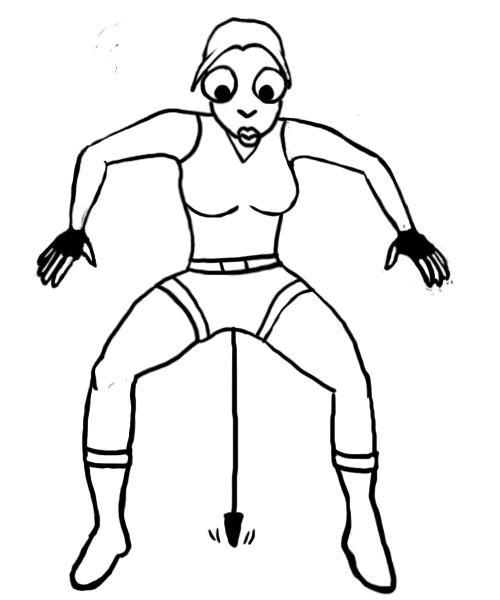
Now imagine a rubber band that is stretched between the outline of both feet. If the weight is above the area that is formed by the rubber band, the figure stands firmly. But this is just the case if the upper body is upright.
Remember: Consider the centre of mass and adjust the pose to it.
Now a little example. Lara should stand casually with a tilted hip. For this purpose I tilt the whole object around the base mesh, the butt. Then tilt back the legs and torso.
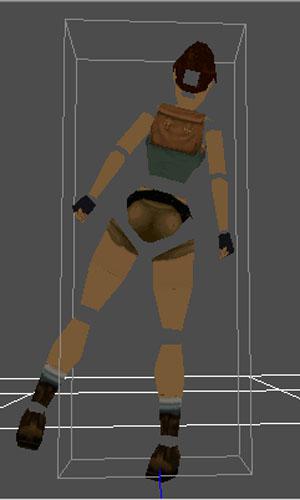

In the right frame I pushed the left leg further under the body. Why? Humans stand this way, because it relieves one leg from the body weight. In this case the right leg is relieved. The left one has to carry more of the body weight. Thus it has to be closer to the centre of masse. Think of the dangling weight! Nonetheless, the pose is quite awkward. After I did some small corrections it looks like this.
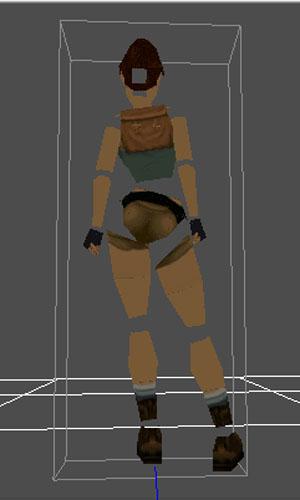
This is much better, isn't it? What have I done? First I dropped the right arm a bit. Otherwise I would be exhausting to hold it up in the prior position. Another subtil but very important step is fixing the shoulders to the hips. Take a close look: The left shoulder is dropped further than the right one. The overall pose looks more relaxed and more stable.
This is not the way you should do it:

Aaaaah.
Remember: The positions of hips and shoulders is nearly always opposed to each other in still positions and movements.
Back to the example. Even if the pose is now correct in terms of statics, it still looks kind of forced. You may want to try standing in this position. You feel like a gorilla, don't you? Where do you put these dammed hands? Lara can't hold onto a “random” beer or cigarette. So what now? Let's have a look what professionals do, who have to stand around in public with empty hands a lot.
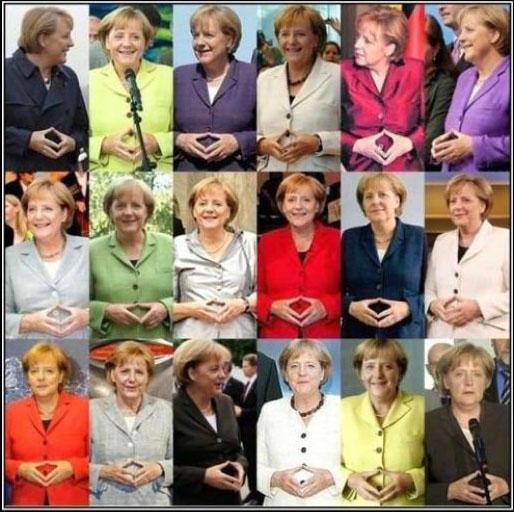
No, let's better take a pose from the commercial catalogue.

Remember: If your character has nothing to do, don't let him/her stand around like a gorilla with numb arms.
At least we finally know why Lara is holding on to her weapons a lot. ;-)
Walking Animations
I dedicate a small chapter to walking, since it is the most common animations in cut scenes. Walking is a complex sequence of movements. But with the knowledge that already acquired you should be able to build a decent animation.
Those are the things that you should think of.
- One foot has always contact to the ground.
- The feet are in every phase of the movement parallel and about hip wide apart. But there are other stiles of walking! If you want to achieve a natural movement, don't take catwalk models as a reference. They are walking with both feet on an imaginary line, sometimes they even cross the line. Men tend to walk with feet turned outward.
- The hip tilts a little bit (!) upwards on the side of the leg that is carrying the bigger part of the body weight. The shoulder on this side moves according to the hip-shoulder-counter movement a little bit downward.
- In the same way, the hip turns a little bit (!) forward, if the foot on this side goes forward. The shoulder moves backwards at the same time. If you overdo this shoulder movement, you end up with a douchebag walking style.
- The arms swing contrarly to the legs. Don't overdo the arm movements, but don't to the numb arm gorilla, either.
Here an example.
The first animation is deliberately bad. It shows how important animation of hips and shoulders is. The whole movement looks terribly stiff. The second animation considers a soft “bounce” with every step and the hip shoulder countermovement. I made it very subtle on purpose so you can see how important even those tiny movements are for the overall impression.
The disadvantage of the second approach is the large amount of time that you need. The second animation took me more than the threefold time of the first one, since every movement of the butt leads to necessary corrections of legs and torso. And the animation is still not perfect!
Remember: There is no way to avoid the fact that good animation takes a lot of time.
Shifting of the body weight
NNow another example. Lara wants to pick up something from the ground in front of her feet. This is easy, isn't it? You simply tilt the body forward and drop an arm. Right?
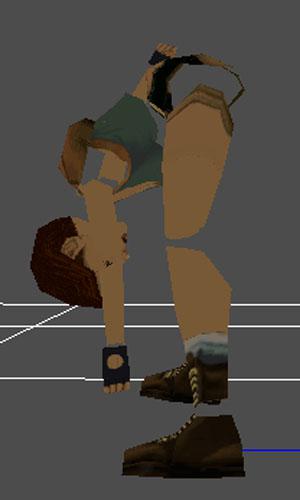
Nope, this looks strange.
Try standing with your back on a wall and picking up something in front of your feet. If you succeed, you may congratulate yourself for your good body control. Most people will fail at it. The reason is the shifting of the body weight by bowing of the torso. Our muscles can compensate a part of weight shifting so we don't have to change our posture. However, this is exhausting. Thus we tend to evade the forces by shifting of the body. If you take a bow, the weight of the torso goes forward. The centre of mass shifts towards the toes, or even further. If we do not stand with the butt against a wall, we compensate this by pushing the butt towards the heels. We don't need to think about it. As toddlers we took many swan dives into the floor. The correct movement is burned forever in our muscle memory. This looks better. The difference is subtle, but the resulting impression is way better.

Who can touch the toes with the fingers? Can you? :-D
Well, Lara is very flexible, so she won't have a problem with this exercise. However, if you want the movement to look less like a gymnastic exercise, bend the knees slightly. By this, the muscles on the back of the legs don't get stretched that much.
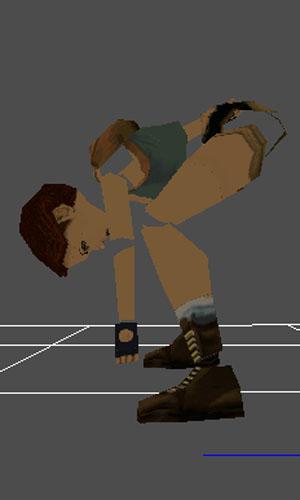
There is only one problem left. The posture is not very ladylike. o.O

But this was not the goal of this example. ;-)
Remember: Decide, wether a movement should look acrobatic/tense or relaxed/casual. If the last is the case, avoid stress or stretching of the muscles and use evasive motions.
It does not hurt to learn about the most important muscles and their subsequent functions. ;-)
Carrying stuff
What happens if one carries a heavy object? This is easier than it seems if you use what you have already learned. Look at the body and the object as one unit and think about the centre of mass. If you carry a heavy box, you have to find a way to get the centre of mass above the imaginary area between the feet. Otherwise you will fall over. Here are some possible ways that are more or less practicable:
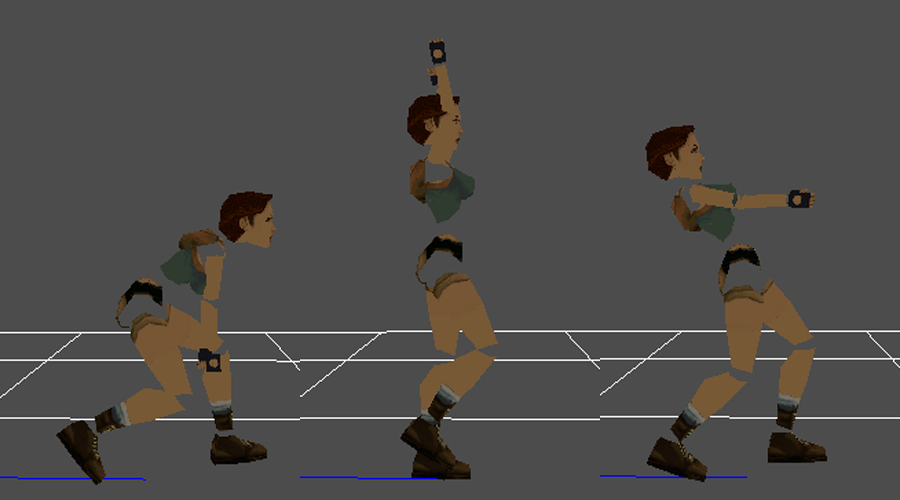
You will ruin you back with the first strange posture. The second one is not obvious, but your back will be thankful for it. The version on the right side will probably be used by most people for short distances.
Remember. The same rules apply to characters carrying objects. Just look at the body and the object as a unit.
Applying force to an object by the whole body
If Lara pushes an heavy object, pulls a chain or pushes a plate into the wall, she shifts her weight to support the muscle work.
This wall lever looks very free-moving.
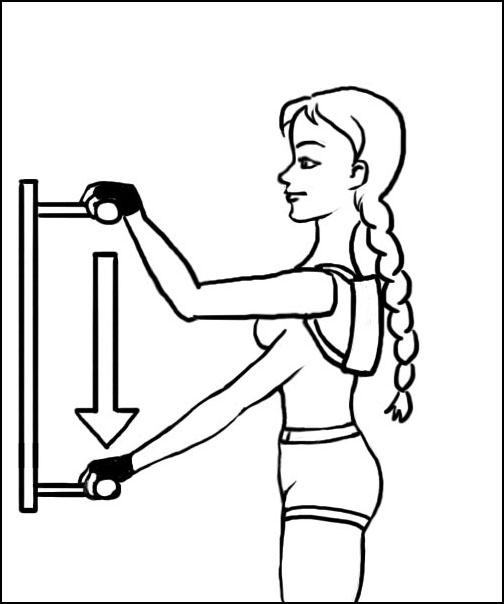
But how can you achieve the impression that Lara has to fight a bit more to move it, like you would expect from an antique mechanism? Let her use the weight of her upper body! Let's look at the classic lever animation.

As she pulls the lever she hangs a bit on it, so the weight also pulls it down. In the second phase she pushes down with the upper body. Looks more like work, doesn't it? If muscles alone won't succeed, it might be necessary to use the whole body weight.

Remember: Muscle work does not look that much like struggle. Use additionally shifting of the body weight.
If you want to publish this text or parts of it elsewhere, please ask Codo for permission previously!
As every year there is also the TRForge advent calendar contest. Achieve the matching challenge to every calendar door and collect points, to get the chance to win a great prize in the end! You can find more infos here: contest, or you can click on Lara at the calendar page.
